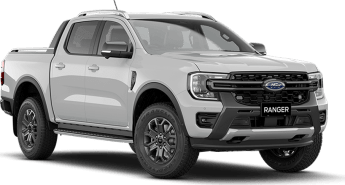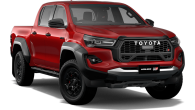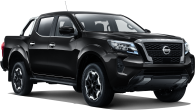Beginning from $63,690 before on-road costs and based on the XLT grade, the Sport is only available with the Double Cab pick-up body for now, and adds contrasting blacked-out themes inside and out, as well as two front tow hooks, 18-inch alloys, wireless charging, an Off-Road screen showing 4WD activation and other related settings, a skid plate, LED front fog lamps and all-season tyres.
Luxuries include leather upholstery, a powered driver’s seat with eight-way adjustment, wireless charging and two front mats.
These all come on top of the XLT's 10.1-inch touchscreen with Ford’s Sync4 multimedia system, digital instrument cluster, USB-A and -C ports, cloth seats, power windows, keyless entry and start, dual-zone climate control, sat-nav, a leather-wrapped steering wheel, leather-sheathed steering wheel and gear knob, intelligent adaptive cruise control with full stop/go functionality and traffic-sign recognition and lane-centring tech.
Naturally, like all Rangers, the Sport buyer also secures nine airbags, AEB autonomous emergency braking, adaptive cruise control, lane departure alert and lane keep assist and rear parking sensors, as well as blind spot warning and cross-traffic alert tech.

The Sport is available only as a 4x4.
The rear cargo area comes with a black sports bar, rear box illumination, a bedliner with a 12-volt socket, securing points at the front of the load box, box capping with integrated fixing points for added sheetmetal protection, a rear load box step for easy side access and a lighter tailgate, thanks to Ford's 'easy lift assist' system.
A built-in trailer wiring set-up is also included, as well as the tow bar itself for Ranger Sport.
Mirroring the XLT and Wildtrak, the Sport offers a pair of engine choices.
The previous 3.2-litre five-cylinder turbo-diesel has been dumped for a revised version of the 2.0-litre twin-turbo diesel (dubbed BiTurbo in Ford-speak). Mated to a completely overhauled 10-speed automatic, it delivers 3kW less power at 154kW at 3750rpm, but the 500Nm torque maximum (between just 1750-2000rpm) remains. The transmission includes up to six driving modes.
The 3.0-litre V6 turbo-diesel that's distantly related to that found in Australia's Ford Territory is the Sport's other engine option.
It delivers a healthy 184kW at 3250rpm and 600Nm at 1750-2250rpm.
The V6 sends drive through to a new electronic on-demand four-wheel-drive system, with full-time 4WD that varies drive to the front or rear wheels as required. It includes six driving modes: Normal, Eco, Tow/Haul and Slippery for on-road driving, and Mud/Ruts and Sand for use off-road. Each alter engine throttle, transmission, braking, traction and stability controls.
There’s also an electronic rear differential lock which can be activated via the SYNC 4A multimedia screen, for improved off-road traction.
Note that Ranger 4x4s with either 2.0-litre engine stick with the standard part-time 4x4 set-up that offers 4x2 (rear-drive), 4x4 Low range and 4x4 High range.
Ford Ranger 2023: Sport 2.0 (4X4)
| Engine Type | Diesel Twin Turbo 4, 2.0L |
|---|---|
| Fuel Type | Diesel |
| Fuel Efficiency | 7.6L/100km (combined) |
| Seating | 5 |
| Price From | $57,530 - $66,110 |
| Safety Rating |
|
Pricing Guides




.jpg)

_0.jpg)







.jpg)


.jpg)
.jpg)
.jpg)



.jpg)

Comments